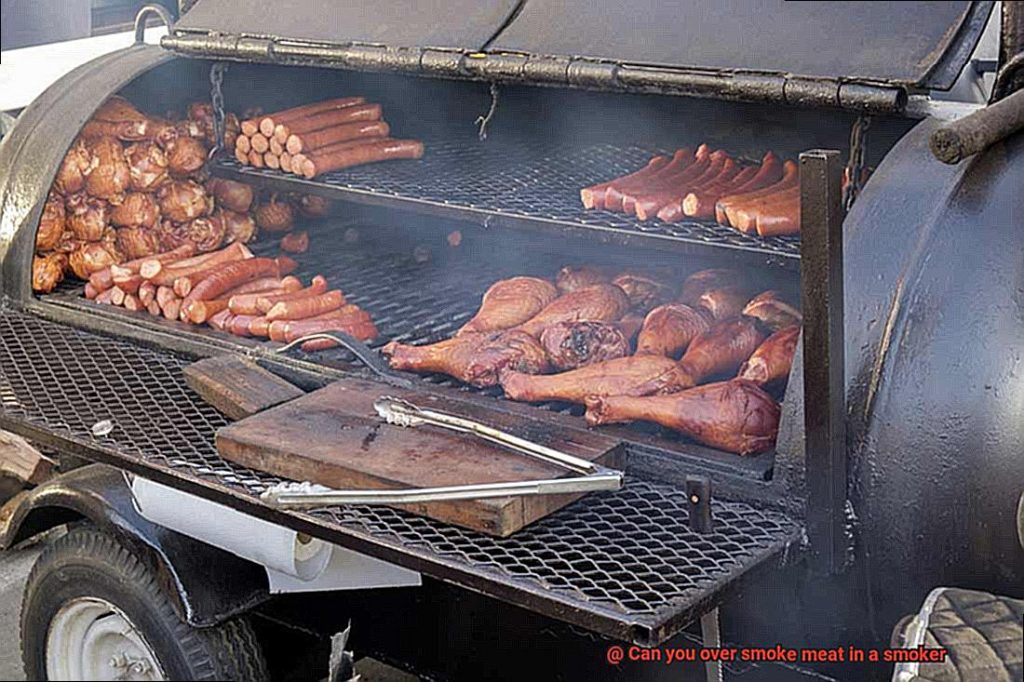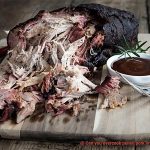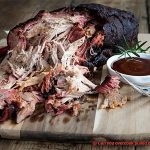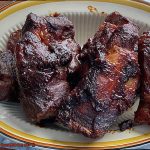Imagine this: you’re in your backyard, surrounded by friends and family on a lazy afternoon. You’ve spent hours perfecting the art of smoking meat, and your brisket is slowly cooking to tender perfection. You’re feeling pretty confident until a sudden thought hits you – can you over smoke meat in a smoker? Will all your hard work go to waste?
As an expert on all things smoked meat, I’m here to tell you that yes, it’s entirely possible to over smoke meat in a smoker. In fact, it’s a common mistake that many people make. Over smoking can ruin the flavor and texture of your meat, leaving you with something dry, tough, and downright inedible.
But don’t worry. There are simple tips and tricks that you can use to ensure that you never over smoke your meat again. By understanding the smoking process and carefully monitoring your smoker, you’ll be able to achieve perfectly smoked meat every time.
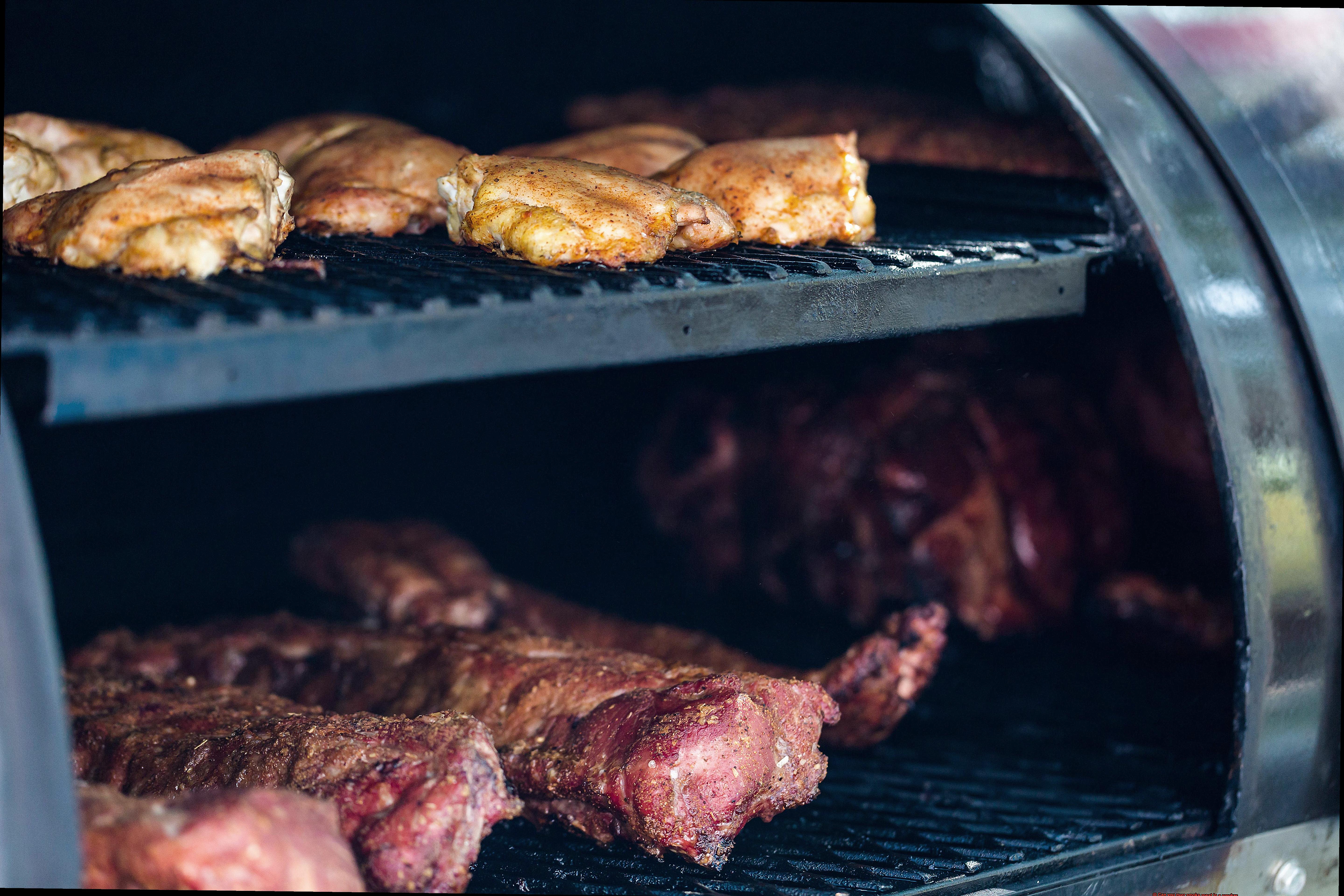
In this blog post, we’ll dive into what exactly it means to over smoke meat, the common mistakes people make when smoking their meats, and the steps you can take to prevent it from happening. By the end of this post, you’ll be a smoking pro – impressing your guests with perfectly smoked meat every single time. So let’s get started.
Contents
What is Over Smoking?
Smoking meat is a culinary art that requires a gentle balance of temperature, smoke, and time to achieve the perfect flavor and texture. However, novice smokers often make the mistake of over smoking their meat, leading to bitter, acrid tastes and even inedible results.
Over smoking occurs when too much wood or pellets are used to produce smoke or when the meat is left in the smoker for too long. Additionally, poor ventilation can also lead to over smoking. The length of time required to smoke meat varies based on factors such as the type of smoker used, thickness of the meat, and smoking temperature. For instance, a brisket may require up to 12-16 hours at low temperature while a chicken may only need 3-4 hours.
Over smoking can have disastrous consequences for your meat and health. Excessive smoke can contain chemicals such as benzene and formaldehyde that can be harmful to your respiratory system and overall health if inhaled in large quantities.
One major issue with over smoking is that it can overpower the natural flavors of the meat with an intense smoke flavor. Additionally, over smoked meat may become dry and tough, which is not ideal for most people.
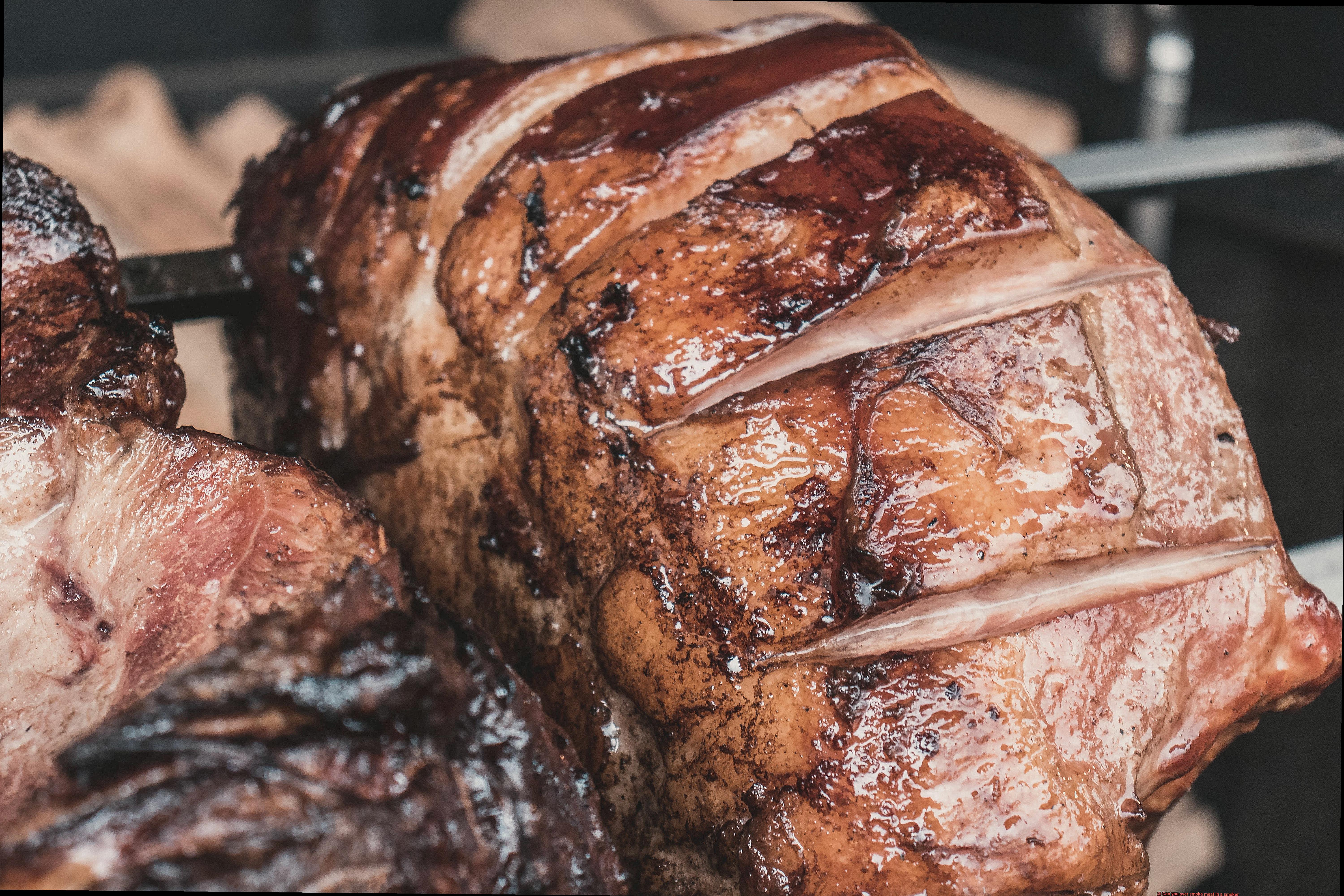
To avoid over smoking, it’s essential to monitor smoke production during the cooking process and use the right amount of wood or pellets for the type of meat being smoked. Proper ventilation is also crucial. Following recipes and guidelines for smoking meat can help you achieve delicious and flavorful results every time.
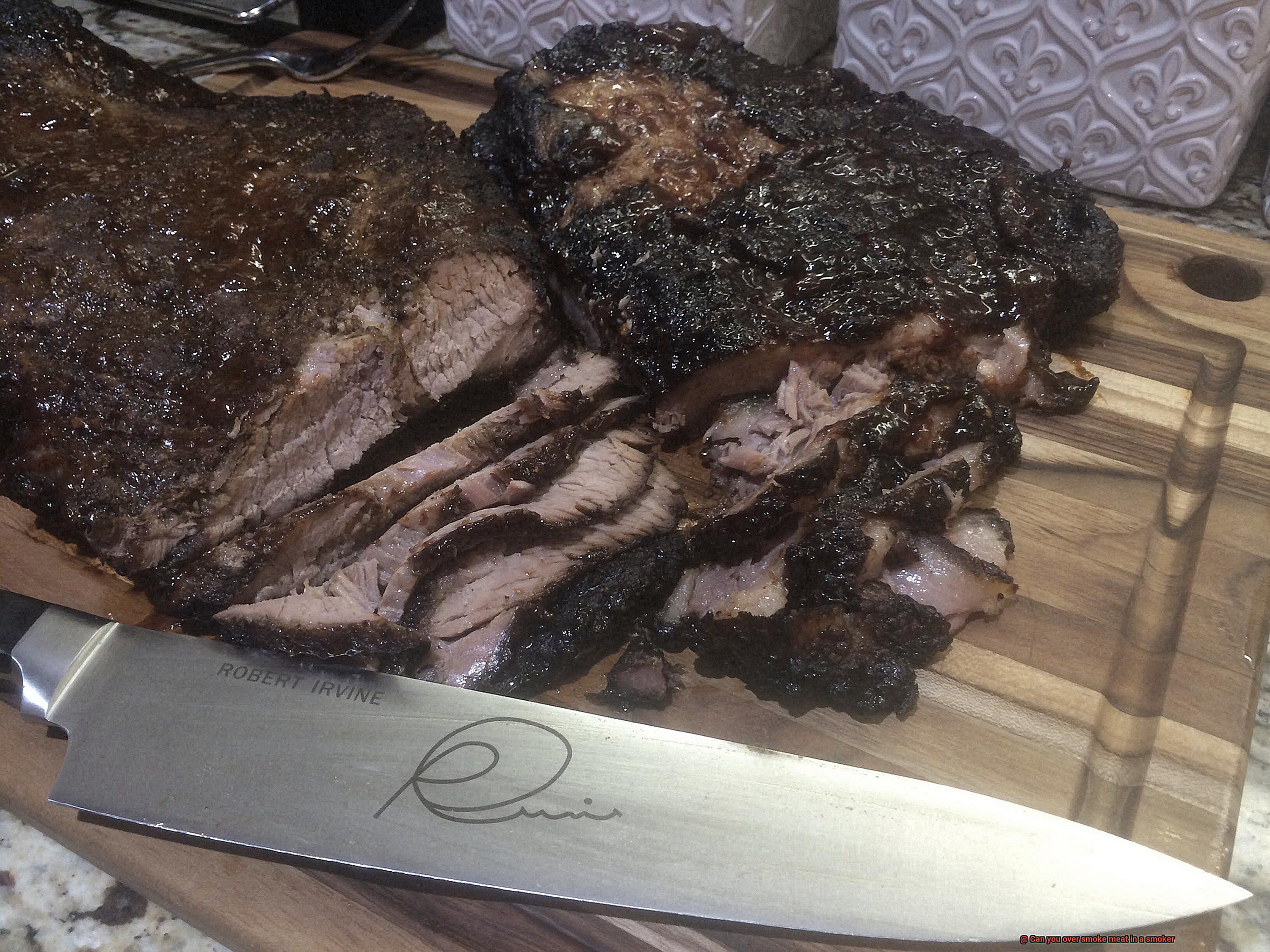
What are the Issues with Over Smoking Meat?
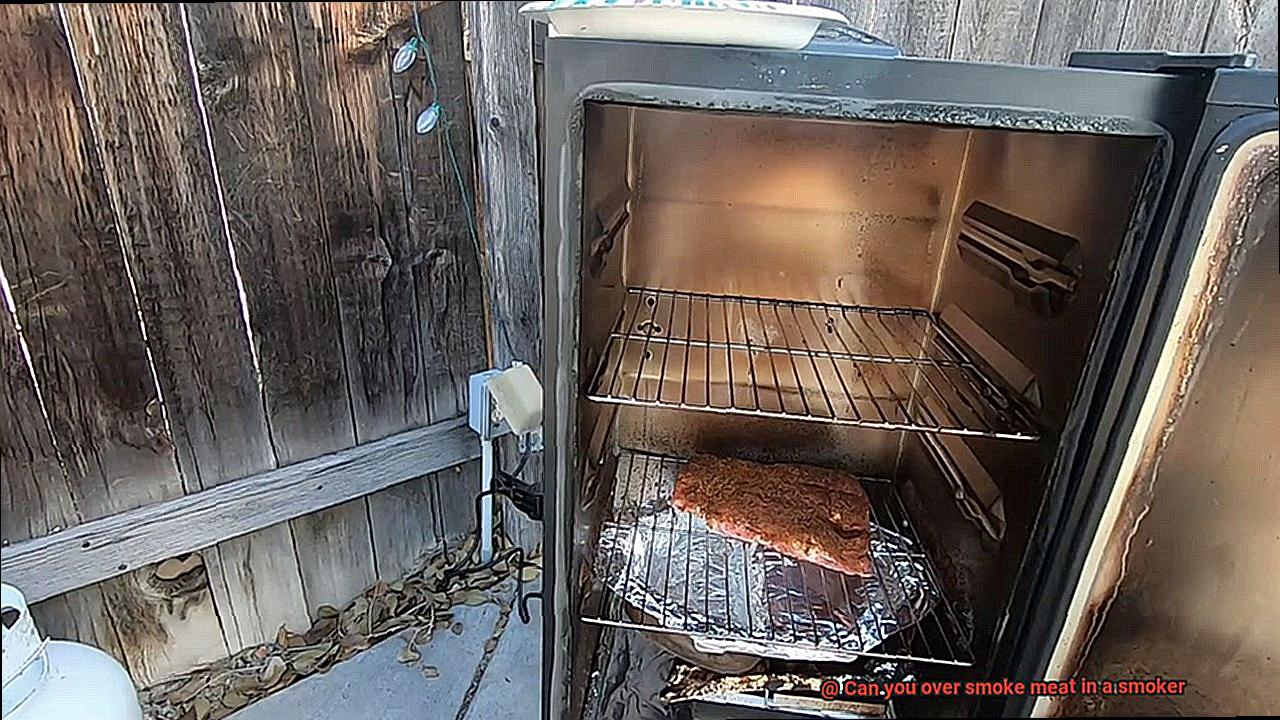
Imagine spending hours preparing a succulent cut of meat, seasoning it to perfection, and carefully placing it in your smoker, only to end up with dry, tough, and bitter meat. What went wrong? You may have fallen victim to the most common pitfall of smoking meat – over smoking. Over smoking can lead to several issues that can ruin the taste, texture, and appearance of your meat.
Firstly, over smoking can make your meat dry, tough, and bitter. Smoke particles can penetrate deep into the meat and change its flavor profile. When it is overdone or exposed to too much smoke, the natural juices in the meat can evaporate, leaving it dry and tough.
Secondly, overexposure to smoke can cause the formation of creosote, a thick black crust on the surface of the meat. Creosote tastes bitter and can be harmful to your health if consumed in large amounts. It can also cause an unpleasant texture and appearance.
Thirdly, when meat is exposed to high temperatures, such as those found in a smoker, harmful compounds like polycyclic aromatic hydrocarbons (PAHs) and heterocyclic amines (HCAs) are formed. These compounds have been linked to cancer and other health issues. Thus over smoking meat can pose a health risk.
Furthermore, over smoking can mask your meat’s natural flavors. This is particularly troublesome if you are using high-quality cuts of meat that are already full of flavor. If you aren’t careful with the amount of smoke you use, you might end up with a dish that is too smoky and unappetizing.
To avoid these pitfalls, it’s crucial to monitor your smoking process carefully. Stick to recipes and guidelines and use the right amount of wood or pellets. Keep an eye on smoke production and avoid exposing your meat to too much smoke or heat. By doing so, you’ll be able to achieve a perfectly smoked piece of meat that is juicy, tender, and delicious.
How to Avoid Over Smoking Meat in a Smoker?
It’s all too easy to overdo it and end up with an unpleasantly bitter flavor. To make sure your next smoking session is a success, follow these tips on how to avoid over smoking meat in a smoker.
Tip 1: Use the Right Amount of Wood
Using too much wood is a common mistake that can result in over smoked meat. The amount of wood you use depends on your smoker type and the type of wood you’re using. A good rule of thumb is to use no more than 4-5 chunks of wood for every hour of smoking. This will ensure that the meat absorbs just the right amount of smoke for a delicious flavor.
Tip 2: Control the Temperature
The temperature inside your smoker is another essential factor in preventing over smoking. The ideal temperature for most meats is between 225-250°F. If the temperature goes too high, the meat will cook too quickly and absorb too much smoke, leading to an over smoked flavor. Use a thermometer to keep an eye on the temperature and adjust it as needed.
Tip 3: Monitor the Smoke Color
The color of the smoke coming out of your smoker is also crucial in avoiding over smoking. Thin blue smoke means that the wood is burning cleanly and not producing too much smoke. Thick white or gray smoke indicates that the wood is not burning properly and can lead to over smoking. Make sure you’re using quality wood and ventilate your smoker properly to ensure clean burning.
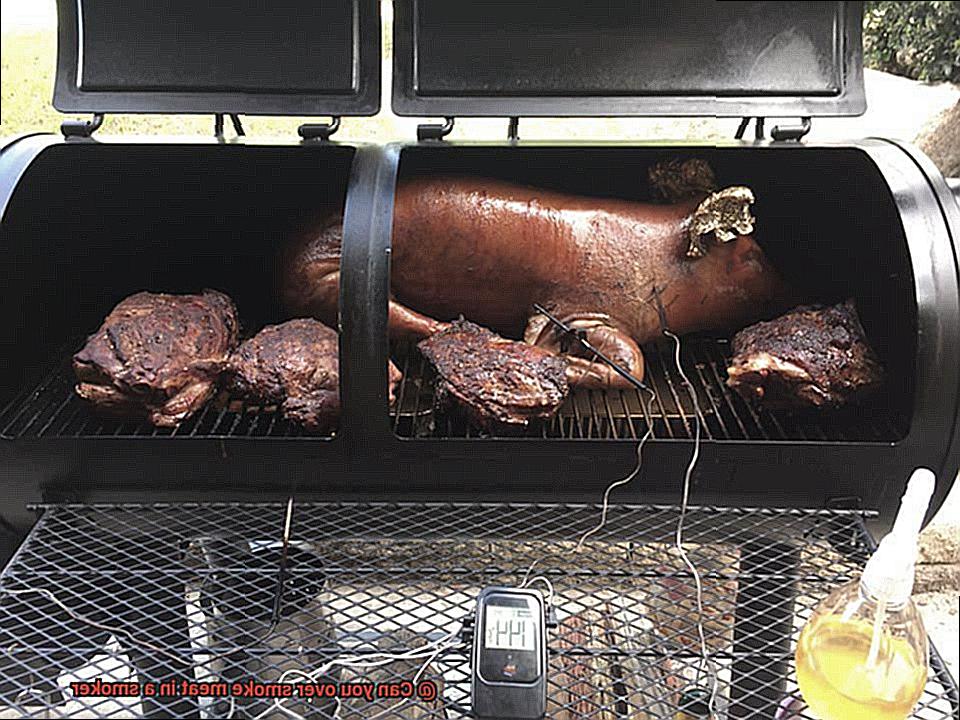
Tip 4: Use a Meat Thermometer
Using a meat thermometer is an excellent way to guarantee that your meat is cooked correctly and not over smoked. Different types of meat require different internal temperatures to be cooked properly, so make sure you know what temperature to aim for before you start smoking. Once your meat reaches that temperature, it’s time to take it out of the smoker and enjoy.
Tip 5: Check the Meat Periodically
Checking the color and texture of your meat periodically can help you avoid over smoking. Over smoked meat will have a dark, almost burnt appearance and a tough texture. If you notice these signs, it’s time to take your meat out of the smoker. Use a sharp knife to cut into the meat and check for doneness.
Tips for Properly Ventilating a Smoker
Smoking meat is an art form that requires attention to detail and patience. One crucial aspect of smoking meat is proper ventilation to ensure the perfect balance of smoke and flavor. Over-smoking can lead to bitter-tasting meat that ruins your dish, so it’s essential to follow these five tips for properly ventilating a smoker:
Airflow is Key
Proper ventilation starts with sufficient airflow inside the smoker. A smoker with vents on both the top and bottom allows air to circulate freely, preventing smoke from getting trapped inside.
Temperature Control
The temperature inside the smoker can significantly impact the amount of smoke produced. If the temperature is too high, adjust the vents to reduce airflow and lower the temperature. Conversely, if the temperature is too low, open the vents more to increase airflow and raise the temperature.
Choose Your Wood Wisely
Different types of wood produce varying levels of smokiness. Hickory wood produces a strong smoky flavor, while fruitwoods like apple or cherry yield a lighter smoky flavor. Choose the type of wood chips that suit your desired level of smokiness.
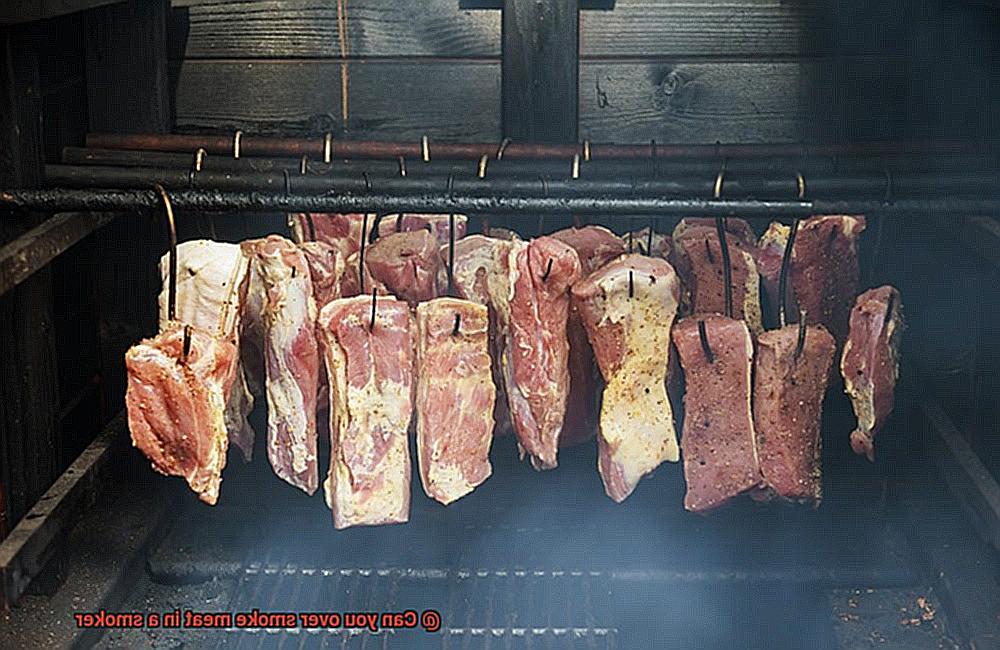
Cleanliness is Key
Regularly clean your smoker to prevent a build-up of ash and debris that can block the vents and reduce airflow. Clean out the smoker after every use, and check the vents before starting a new smoking session.
Avoid Overcrowding
Overcrowding your smoker with too much meat or wood chips can lead to poor air circulation and over-smoked meat. Space out the meat inside your smoker to allow for proper air circulation, using only enough wood chips to produce the desired amount of smoke.
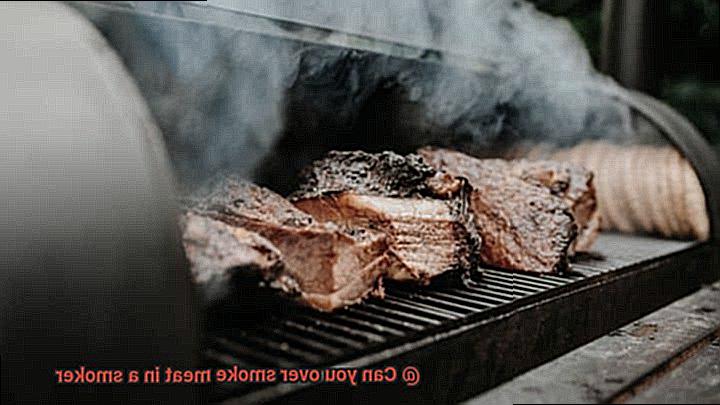
The Right Amount of Wood and Other Smoking Materials to Use
Smoking meat is a culinary quest that requires the right tools and techniques to create something exceptional. One of the most critical factors in achieving perfectly smoked meat is using the right amount of wood and other smoking materials.
To start, it’s essential to prioritize airflow in your smoker. This will help direct the perfect balance of smoke and flavor to your meat. Once you have proper ventilation, you can start controlling the temperature and selecting the right wood.
But how much wood should you use? A general guideline is to use 1-3 ounces of wood per hour of cooking time. However, this can vary depending on the type of wood or smoking material you’re using and the size of your smoker.
When selecting smoking materials, it’s vital to consider the type of meat you’re smoking. For instance, fish and poultry may require less smoke than beef or pork. Additionally, the thickness of the meat can impact how much smoke it can handle.
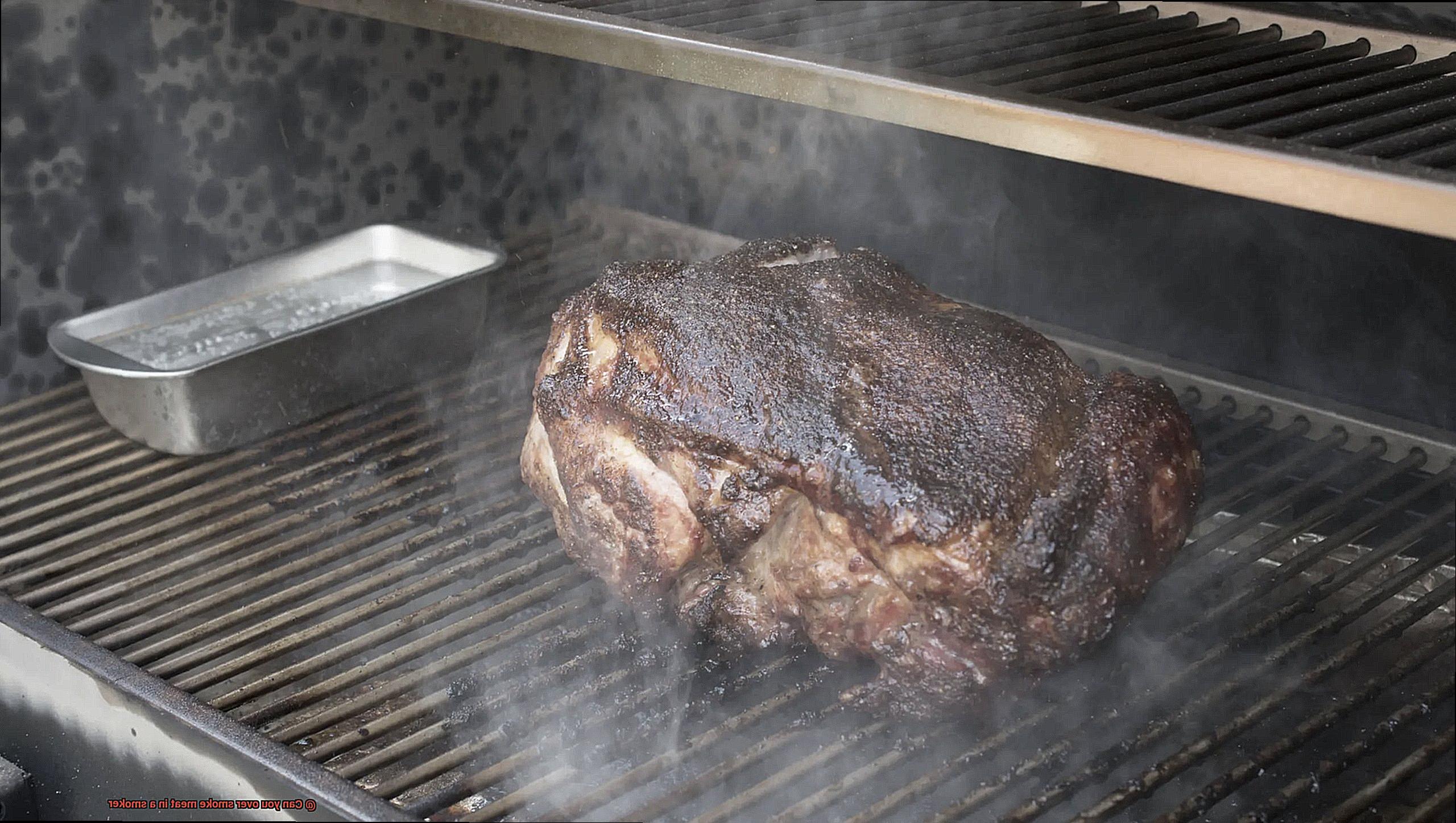
It’s also crucial that your wood or other smoking materials are properly seasoned and dry. This will help ensure that the smoke produced is clean and not too heavy. Here are some other essential tips to keep in mind when using wood for smoking:
- Use hardwoods, such as oak, hickory, or maple, which burn slowly and produce a more robust smoke flavor.
- Avoid softwoods, such as pine or cedar, which can produce an unpleasant taste and harmful toxins.
- Soak wood chips or chunks in water for 30 minutes before use to prevent them from burning too quickly.
Remember that experimentation is key. Every smoker is different, and what works for one person may not work for another. So don’t be afraid to try different amounts of wood and smoking materials until you find what works best for you.
How Long Should You Leave the Meat in the Smoker?
Step into the world of smoking meat, where perfect timing is the key to achieving mouth-watering, tender, and succulent meat. The question on every meat smoker’s mind is, “How long should you leave the meat in the smoker?” Fortunately, we have the answers to guide you through this smoky journey.
One of the critical factors to consider when smoking meat is the type of meat you are cooking. Beef, for example, takes longer to cook than pork or poultry because it has a denser texture. As a general rule of thumb, smoke your meat for approximately 1 hour per pound. However, this is just a guideline that will need to be adjusted based on the specific circumstances of your meat.
The size of the cut and the temperature of your smoker are also factors that will affect your cooking time. Smaller cuts of meat may require less time in the smoker, while larger cuts may need additional time to reach the desired temperature. In addition, different types of smokers have varying heating capabilities that can affect cooking times. Electric smokers are known to cook faster than other types due to their ability to maintain consistent temperatures.
One critical aspect of smoking meat is monitoring its internal temperature using a meat thermometer. The safe internal temperature for meat varies depending on the type of meat you’re smoking. As a general rule, you should cook your meat to an internal temperature of at least 145°F (63°C) to ensure it is safe to eat.
Remember, smoking meat is an art that requires practice and experience. Experimenting with different techniques and making adjustments until you find what works best for you is essential. By keeping a close eye on your meat while it’s in the smoker and making necessary adjustments based on unique factors involved in your specific situation, you’ll be able to achieve the perfect smoky flavor and juicy texture for your favorite cuts of meat.
How Can You Tell if You Have Over Smoked Your Meat?
However, even the most seasoned grillers can make the common mistake of over smoking their meat. This can result in dry, tough, and bitter-tasting meat, which is not what you want after all your hard work. So, how can you tell if you have over smoked your meat in a smoker? Here are some key indicators to look out for:
- Color: The color of your meat can give you the first hint. If your meat appears dark, almost blackened or charred, it is likely that it has been exposed to too much smoke. Prolonged exposure can cause the meat to become excessively dark and burnt.
- Taste: Over smoking can result in a bitter taste in your meat. When too much smoke has been used during the cooking process, it can overpower the natural flavors of the meat. If your meat tastes overly smoky or bitter, then it has been over smoked.
- Texture: Your meat’s texture is also an essential indicator of over smoking. If your meat feels tough and dry, it may have been exposed to too much smoke. Over smoking can cause the moisture in the meat to evaporate, resulting in tough and dry meat that is unappetizing to eat.
- Aroma: The smell of your meat can also provide clues as to whether it has been over smoked. If the smell is overly smoky or burnt, then it is likely that the meat has been exposed to too much smoke.
Health Risks Associated with Over Smoking Meat
While it’s undeniably delicious, over smoking your meat can pose serious health risks. When meat is over smoked in a smoker, it can produce harmful chemicals such as polycyclic aromatic hydrocarbons (PAHs) and heterocyclic amines (HCAs). These chemicals have been known to increase the risk of cancer and are definitely not something you want to mess around with.
PAHs are formed when fat drips onto the hot coals or wood chips, creating smoke that rises and clings to the meat. The longer the meat is exposed to smoke, the higher the levels of PAHs can become. HCAs, on the other hand, are produced when meat is cooked at high temperatures, causing the amino acids and creatine in the meat to react with each other. This means that if you’re smoking a fatty cut of meat for too long or at a high temperature for too long, you’re increasing the levels of these harmful chemicals in your food.
So, how can you enjoy delicious smoked meats without compromising your health? Here are some tips:
- Avoid direct exposure to smoke: Try using indirect heat instead of placing your meat directly over the coals or wood chips.
- Use lean cuts of meat: Fatty cuts of meat drip more fat onto the coals or wood chips, increasing the levels of PAHs in your food.
- Marinate your meat: Marinating your meat before cooking can help reduce the formation of harmful chemicals.
- Don’t char or burn your meat: Charring or burning your meat can increase the levels of HCAs in your food.
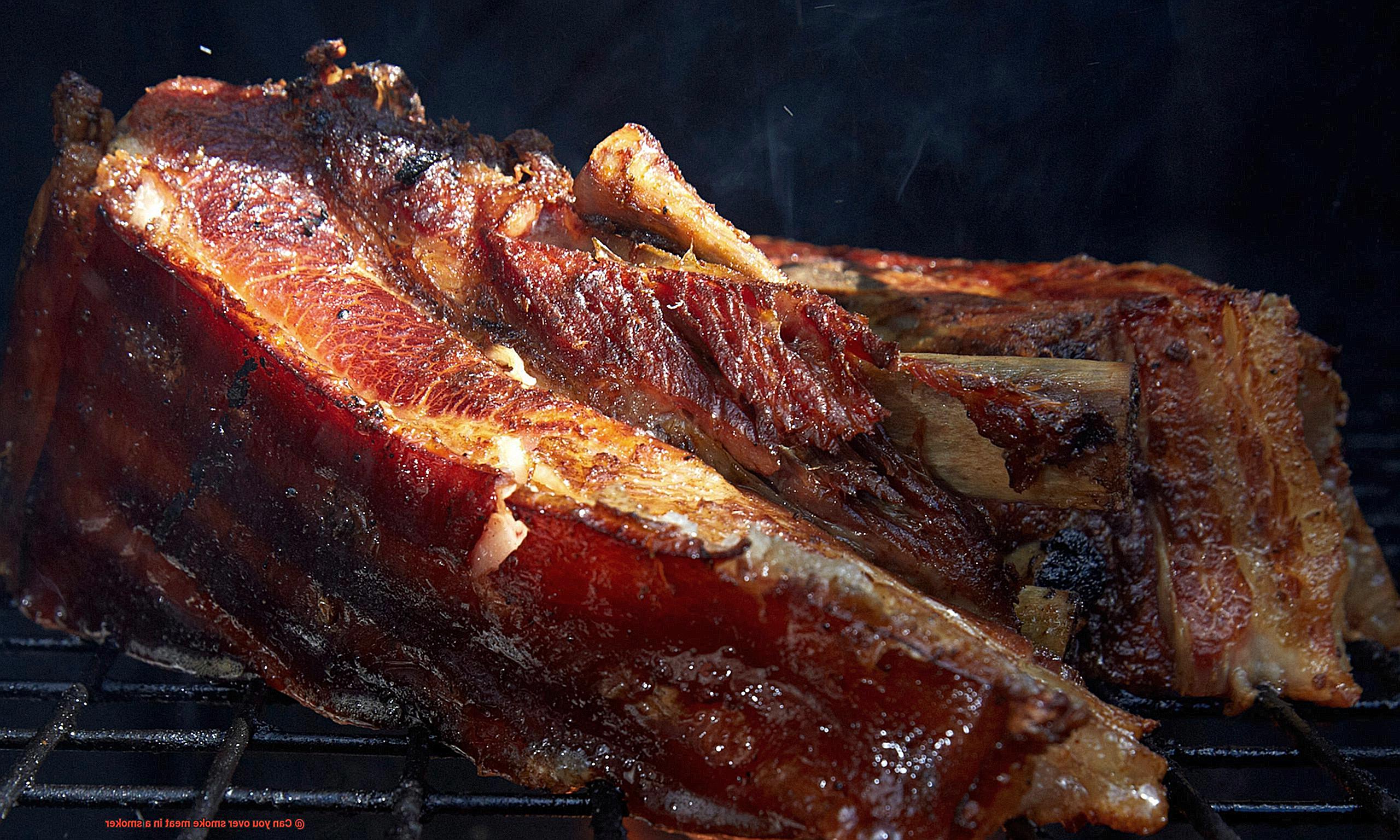
It’s important to note that while some level of smoke flavor is desirable in smoked meat, excessive smoking can be harmful. The American Cancer Society recommends limiting exposure to PAHs and HCAs by taking these precautions.
htaZqsnxAIY” >
Conclusion
In summary, over smoking meat in a smoker is a frequent error that can easily wreck the flavor and texture of your meat. Not to mention, it can also lead to some serious health hazards due to the formation of harmful chemicals like PAHs and HCAs. But don’t fret. With a proper understanding of the smoking process and careful monitoring of your smoker, you can avoid over smoking and achieve mouth-watering smoked meat every time.
To prevent over smoking, it’s crucial to use just the right amount of wood or pellets according to the type of meat being smoked. Keep an eye on smoke production during cooking, control the temperature inside your smoker, and ensure proper ventilation. Additionally, periodically checking the color, texture, aroma, and internal temperature of your meat will help you steer clear from over smoking.
Choosing high-quality wood or other smoking materials that are properly seasoned and dry is also critical. Different types of wood produce varying levels of smokiness; hence experimentation is key to finding what works best for you.
All in all, with proper techniques and precautions in place, you can relish delicious smoked meats without compromising your health.

